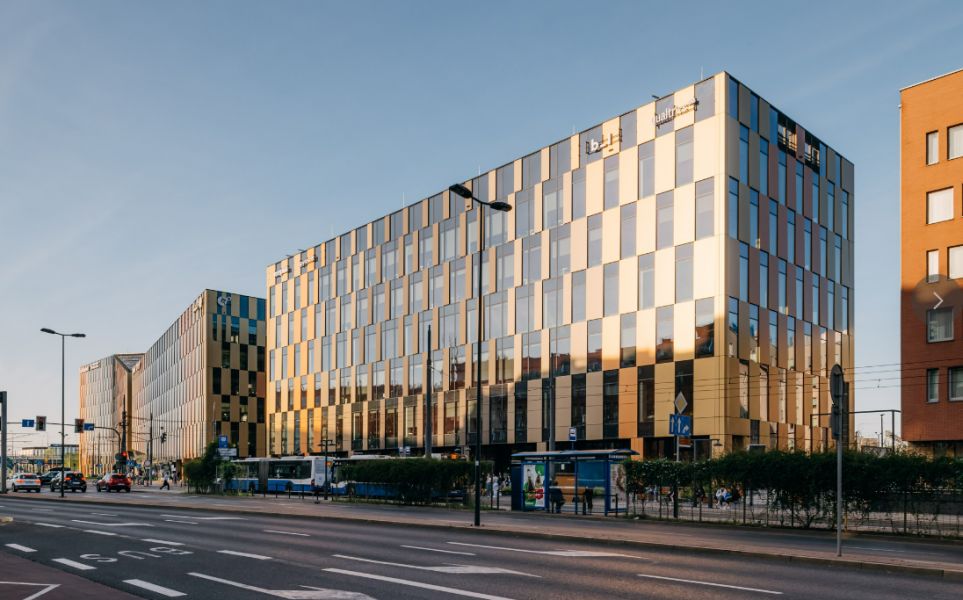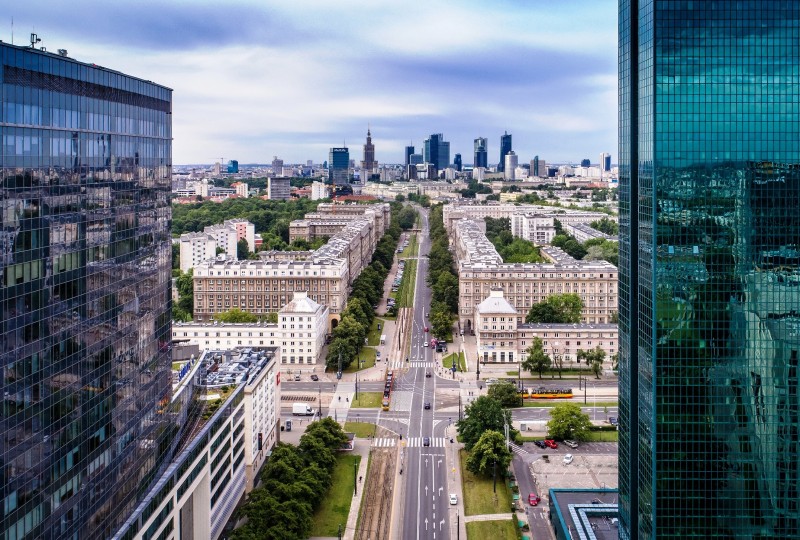Ways of effective investing
The land deficit means that investors are forced to look for non-standard ways to implement new projects in the best locations in the cities and find opportunities to increase the value of commercial facilities
Every year, Polish commercial real estate market proves that it can develop even faster, both in terms of resource growth and transactions. Poland, which is a strong leader among the new EU member countries, is increasingly interesting for investment funds and the world's largest industry players.
However, developers who want to build in the central parts of the largest agglomerations in the country have a difficult task, because the investment areas in the most attractive locations of the cities are long gone. The investors are forced to look for alternative solutions for the implementation of their projects. They opt for, among others, typically difficult revitalization of industrial and historic buildings in well-located industrial areas or renovation of the historic tenements, as well as modernization and demolition of the existing buildings located in the most interesting quarters, to replace them with new facilities of greater cubic capacity.
- In order to reach for the best plots, the investors must look for unconventional ways that can lead to the implementation of investments, such as revitalization of historical facilities, building parking lots, or buying and combining lots for building large projects. Preparation of such investments is more time-consuming, costly and requires the involvement of several parties, such as lawyers, advisers, architects, engineers. Nevertheless, it is now the natural direction of development of the commercial segment in Poland - notes Bartłomiej Zagrodnik, the CEO of Walter Herz consulting company.
Old and new
Numerous revitalizations carried out today are not a new phenomenon on our market. The trend of developing post-industrial areas has been visible for years, both in Warsaw and in the regional cities. Bartłomiej Zagrodnik emphasizes that developers are eager to undertake such activities, knowing that skillfully conducted investments of this type open more possibilities.
- Historic buildings increase the attractiveness of facilities by adding value to them, and the maximum use of existing resources brings tangible benefits. Such investments are usually an invitation to carry out multifunctional projects that combine industrial buildings with modern buildings - explains the expert.
Space that is more difficult to arrange allows for creation of a new, competitive offer on the market. An example of a successful renovation is Hala Koszyki, which has been certainly liked by Varsovians. Its renovation and extension has brought investors success. In addition to the original culinary and commercial concept located in the historic production hall, the complex offers modern office space in two new buildings. The multi-functional Koneser, which is still under renovation, located in the Warsaw district of Praga is still very popular among the largest global companies.
According to Bartłomiej Zagrodnik, the EC Powiśle project where the buildings of the former Powiśle power plant in Warsaw are being renovated, has also been received well on the market. The project will include a shopping area, three new office buildings, a boutique hotel and apartments for rent. The multifunctional ArtN complex implemented at the Norblin factory on Żelazna Street is also popular on the market. In Łódź, after the success of Off Piotrkowska, Monopolis has gained the recognition of tenants. The facility is a result of the renovation of Zakłady Monopolu Wódczanego vodka manufacturing plant. In Gdańsk, the project of developing a 16 hectare area of the former Stocznia Cesarska shipyard seems to be interesting.
Demolition and change of form of use
In places where spatial development plans allow for more intense development, investors decide to demolish the existing buildings to maximize the use of valuable locations. Often, the decisions about changing the purpose of the area are made and the facilities that are created have a different function from the previous ones.
Bartłomiej Zagrodnik points out that most transformations based on demolition are currently carried out in the center of Warsaw. - We are witnessing a very interesting transformation in the central part of the city, where old buildings give way to the new ones – informs the specialist.
- Q22 office building on al. Jana Pawła II Street replaced Mercury Hotel which earlier occupied this plot. Motel One on Tamka Street will be built after the demolition of the old office building. A modern office building at Centrum Marszałkowska was built at the site of Sezam on Marszałkowska Street, and at Daszyńskiego roundabout, the old facility of the Mint of Poland was replaced by Mennica Residence apartment building and Mint Legacy Tower office building - mentions Walter Herz expert.
- There are many examples. At Dmowskiego roundabout, Universal and Rotunda were demolished and will be replaced by a modern version of these buildings. A new office building is also planned on Emilii Plater Street, replacing Emilia pavilion, and on 36 Świętokrzyska Street, where an old building was torn down. Also, in the place of CH Jupiter on Towarowa Street, a modern shopping and entertainment center will emerge - says Bartłomiej Zagrodnik.
The demolition of Ilmet building from 1997, located at the ONZ roundabout, proved to be more profitable, due to the potential of the location. It is to be replaced by a large tower. The buildings from the mid-1990s, located along Kasprzaka Street, where the BGŻ bank's headquarters were located, are to disappear. They will be replaced by new buildings of the Lixa complex. A modern office building providing 28 thousand sq m o space will also replace buildings in the former Warsaw Graphic Works - Dom Słowa Polskiego at Miedziana Street.
Wave of modernization
Owners of the older buildings who want to increase their profitability decide, in turn, to upgrade the standard of real estate through their partial or comprehensive modernization, which often involves a change in the purpose of the facility. The scope of renovation can vary. Sometimes it is enough to lift and make the complex more attractive with interesting functions and amenities that suit the needs of a given location. In other cases, in order for the buildings to be able to become competitive on the market again, they need to be changed completely.
Owners of the older office buildings with a fixed reputation on the market usually decide about their renovation at the right time. However, this is not a common phenomenon on our young market. Older office buildings in Poland are only over 20 years old and there are not many of them. In Warsaw, for example, they constitute only 10 per cent of resources.
Modernization has helped maintain market position and increase the value of real estate in such Warsaw complexes as: Millennium Plaza, Warsaw Financial Center, Adgar Park West, Moniuszki 1A, Ethos, Polna and Piękna 2.0. In Bartłomiej Zagrodnik's opinion, the renovation of older office buildings fits into the usual mode of functioning of commercial buildings. When asked about examples of profitable renovations, Bartłomiej Zagrodnik also mentions WCC building, which after refurbishment started generating large IRR and was sold two years after the purchase with a considerable profit. In addition, P20 building located at Piękna Street, which apart from a better standard has gained a new, exclusive tenant, as well as a recently restored historic tenement at 37 Poznańska Street.
Luxurious hotels in tenements
However, tenement houses play a greater role on the hotel real estate market than on the office market. Independent property owners as well as hotel chains are investing in hotels, which are now often opened in well located tenement houses. Some operators have brands specially dedicated to boutique hotels, located in restored tenement houses in the portfolio.
Nowadays, some projects require adopting several neighboring buildings, which gives the opportunity to introduce solutions that require more space. In this way, nine Gdańsk tenements located in Długi Targ opposite the Neptun fountain and Dwór Artusa will soon house exclusive hotel rooms, because their new owner plans to arrange a luxurious hotel in their interiors.
Remodeling of retail space and shopping centers
Investors are deciding to transform not only hotel and office facilities, but also commercial ones.
- The process of modernization of real estate from this segment is typically supposed to lead to a greater adaptation of the center's profile to the current demand of the local market. In smaller regional cities, there is a trend towards changing the format of commercial facilities into the outlet centers, which are still missing in Poland - notes Bartłomiej Zagrodnik.
In this segment the examples of transformations are also numerous. Galeria Podlaska in Białystok from the classic shopping center has turned into Outlet Białystok outlet center, whereas Galeria Graffica in Rzeszów has transformed into Outlet Graffica. Centrum Glinki in Bydgoszcz is also changing its character and after the reconstruction will become Metropolitan Outlet.
In Poznań, the outdated retail space Franowo after the reconstruction is further serving the residents as a modern Centrum Franowo. Park Handlowy Bielany in Bielany Wrocławskie after thorough modernization and partial demolition, has returned to the market as Aleja Bielany. In Warsaw, Fort Wola which is currently closed will become Galeria na Woli.








